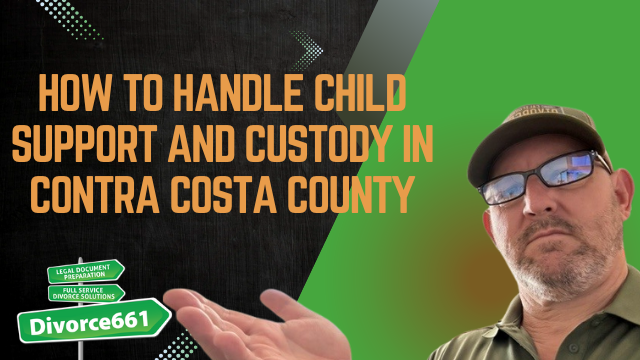How to Handle Child Support and Custody in Contra Costa County
I’m Tim Blankenship with Divorce661. If you’re filing for divorce in Contra Costa County and you have children, two of the issues you’ll face right away are child custody and child support. These topics can feel overwhelming, but with a clear plan and the right tools you can make decisions that protect your children and reduce stress for everyone involved.
Overview: What the Court Looks For
California courts — including those in Contra Costa County — decide custody and parenting arrangements based on the “best interests of the child.” That means the court starts from the presumption that both parents should be involved unless there is a serious reason to limit one parent’s role (for example, safety concerns).
There are two basic custody concepts to understand:
- Legal custody: who makes important decisions about education, health care, and religion.
- Physical custody: where the child lives and how parenting time is shared.
Your parenting plan should clearly state who has legal decision-making authority and a practical schedule for physical custody and visitation.
What to Include in a Parenting Plan
A well-drafted parenting plan removes ambiguity and reduces conflict. At a minimum, your plan should include:
- Where the children will live (primary residence).
- A detailed time-sharing schedule (weekdays, weekends, holidays, school breaks, and vacations).
- How decision-making responsibility is allocated (joint legal custody vs. sole legal custody and how disputes are resolved).
- Procedures for communication between parents and with the children.
- Plans for school, medical care, and extracurricular activities.
- Transportation arrangements and pickup/drop-off logistics.
How Child Support Is Calculated in California
California uses a statewide guideline formula to calculate child support. The formula factors in several things to produce a fair number:
- Each parent’s gross monthly income (including wages, bonuses, commissions, and some benefits).
- The percentage of time each parent spends with the child (time-share or custody percentage).
- Mandatory expenses like health insurance premiums for the child and daycare costs.
- Tax filing status and certain other adjustments.
Courts and family law professionals commonly use a program called DissoMaster (or similar court-approved software) to run the guideline calculation. That makes the result consistent and acceptable to judges, which helps avoid disputes over math and methodology.
Example: How We Helped a Contra Costa Family
We recently assisted a couple in Contra Costa County who had an informal custody arrangement but wanted a legally enforceable agreement. They were worried about whether their informal plan would be considered fair by the court and whether the support number they had in mind would pass review.
Here’s what we did for them:
- Collected financial information and time-share details from both parents.
- Ran the child support guideline calculation using court-approved software to create an objective support number.
- Drafted a clear parenting plan that matched their daily and holiday schedules and addressed decision-making.
- Prepared and filed the judgment and supporting documents with the court to minimize the risk of rejection.
The result: their agreement was approved without issues and they avoided messy court hearings. Having everything prepared correctly the first time saved them time, stress, and money.
Practical Steps to Take Right Now
If you’re starting this process in Contra Costa County, here’s a practical checklist to follow:
- Decide on basic custody goals: joint legal custody? split physical time? a primary residence?
- Gather financial documents: pay stubs, tax returns, health insurance statements, and daycare invoices.
- Create a proposed parenting schedule that addresses weekdays, weekends, holidays, and vacations.
- Run or obtain a guideline child support calculation using DissoMaster or similar software.
- Draft a parenting plan and support order that are detailed, realistic, and court-ready.
- File the documents correctly to avoid delays or rejections from the court clerk.
How a Professional Service Can Help
Many people try to do this themselves and hit roadblocks: incorrect forms, incomplete parenting plans, or support calculations that don’t match the court’s expectations. At Divorce661 we handle the whole package so you don’t have to worry about rejections or missing paperwork.
- We calculate support using court-accepted tools so the numbers will stand up in court.
- We draft your parenting plan to meet Contra Costa County standards and reduce future disputes.
- We prepare and file the judgment and supporting documents accurately so your case moves forward without unnecessary delays.
- We offer a flat-fee, done-for-you divorce solution for amicable separations across California.
Final Thoughts
Child custody and child support are sensitive, important parts of divorce. The more specific and objective your agreements are, the easier they are to get approved by the court and to enforce afterward. Focus on the best interests of the children, document everything clearly, and use tools and professionals that the court trusts.
If you’re going through a divorce in Contra Costa County and want help with child custody, parenting plans, or child support calculations, schedule a free consultation with Divorce661. We’ll help make your agreement clear, fair, and ready for court approval so you can concentrate on what matters most — your kids.

